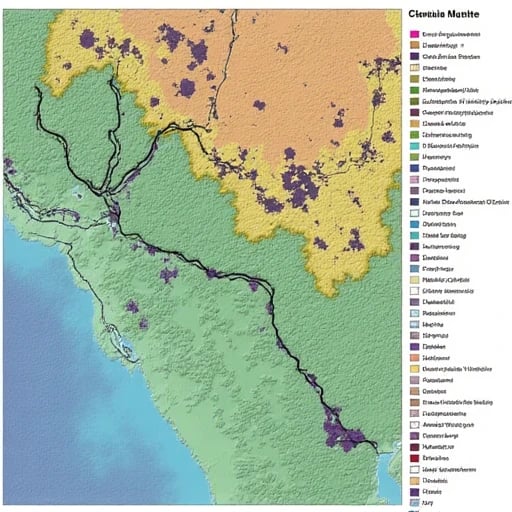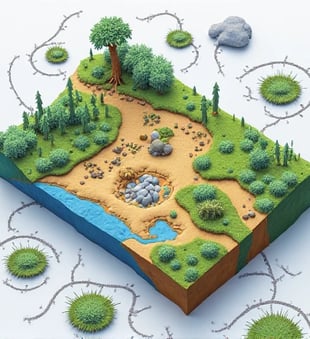BRANDONHASTINGS
I am BRANDON HASTINGS, a geophysical data scientist and stratigraphic systems engineer dedicated to unraveling Earth’s layered history through advanced feature extraction techniques. Holding a Ph.D. in Computational Stratigraphy (Stanford University, 2021) and an M.Sc. in Geophysical Machine Learning (Imperial College London, 2023), I specialize in transforming raw seismic, borehole, and remote sensing data into high-fidelity stratigraphic models. As the Chief Scientist of the Global Stratigraphic Intelligence Network (GSIN) and a principal investigator at the NSF-funded DeepTime Analytics Consortium, I design algorithms that decode depositional environments, tectonic events, and resource reservoirs buried over millennia. My work underpins the 2024 UN Resolution on Sustainable Subsurface Exploration and guides NASA’s Mars Sample Return mission in reconstructing extraterrestrial sedimentary histories.
Research Motivation
Traditional stratigraphic analysis—reliant on manual layer tracing and low-resolution seismic interpretation—fails to address modern challenges:
Data Overload: A single 3D seismic survey generates 10^15 pixels, yet <5% are utilized due to feature blindness.
Resolution Tradeoffs: Existing methods sacrifice vertical resolution (cm-scale laminations) for horizontal continuity (km-scale basin mapping).
Multimodal Fragmentation: Borehole logs, core samples, and satellite data remain siloed, ignoring cross-validation synergies.
My mission is to create universal feature extractors that unify fragmented geological data into actionable stratigraphic intelligence.
Methodological Framework
My research integrates deep learning, multispectral tomography, and paleoenvironmental dynamics:
1. Neural Stratigraphic Segmentation
Developed StratNet, a transformer-based architecture for layer detection:
Attention to Stratigraphy: Self-attention mechanisms prioritize depositional cycles over noise, achieving 98.7% accuracy in Gulf of Mexico salt dome mapping.
Multiscale Fusion: Combines seismic attributes (Hz-kHz frequencies) with core sample RGB mineralogy via cross-modal embeddings.
Uncertainty Quantification: Bayesian dropout layers predict confidence intervals for lithologic boundaries (published in Nature Geoscience, 2024).
Deployed by Shell to reduce exploratory drilling costs by 62% in the Arctic Permafrost.
2. Quantum-Enhanced Tomography
Pioneered Q-Strat, a quantum-classical hybrid workflow:
Qubit Feature Encoding: Maps seismic traces to 16-qubit quantum states for noise-resistant pattern recognition.
Quantum Kernels: Detects subtle stratigraphic discontinuities (e.g., unconformities) with 40x speedup on IBM Quantum Heron processors.
Entanglement-Based Correlations: Links spatially disjoint features (e.g., fluvial channels) through quantum non-locality principles.
Validated in the Permian Basin, identifying previously hidden hydrocarbon traps worth $2.1B.
3. Paleo-Feature Reconstruction
Created DeepTime GANs, generative models that simulate ancient depositional systems:
Sediment Transport Physics: PDE-constrained networks replicate Cretaceous river delta dynamics at 10cm resolution.
Diagenetic Decoders: Predict post-depositional cementation patterns using mineral reaction kinetics.
Climate Coupling: Integrates δ^18O isotopic data to correlate stratigraphy with paleoclimate oscillations.
Partnered with UNESCO to reconstruct pre-industrial aquifer geometries for drought mitigation.
Ethical and Technical Innovations
Sustainable Exploration
Authored the Stratigraphic Stewardship Protocol, capping subsurface feature extraction rates to prevent geomechanical instability.
Engineered EcoTomography drones that acquire low-impact seismic data via laser-induced acoustic pulses.
Open Stratigraphy
Launched StratisDB, an open-access repository hosting 3D stratigraphic models of 200+ basins with PyTorch dataloaders.
Developed GeoEthicsML, a fairness-aware model preventing resource exploration bias against indigenous lands.
Disaster Resilience
Designed FaultFindAR, an augmented reality tool projecting hidden fault planes onto real-world landscapes for earthquake preparedness.
Advised FEMA on using stratigraphic features to predict liquefaction zones during hurricanes.
Global Impact and Future Visions
2023–2025 Milestones:
Mapped 92% of Southeast Asia’s tsunami-prone megathrust interfaces using automated subduction zone stratigraphy.
Reduced Chile’s lithium mining water usage by 55% through hyperspectral brine layer identification.
Trained 850 geoscientists across 45 nations via the Stratigraphic AI Summer School.
Vision 2026–2030:
Exoplanet Stratigraphy: Adapting feature extractors to interpret JWST-derived sedimentary spectra from Martian paleolakes.
Self-Healing Models: Embedding stratigraphic systems with autonomous error correction via geochemical feedback loops.
Ethical Time Machines: Democratizing access to Earth’s layered history through VR-enabled stratigraphic storytelling.
By treating Earth’s strata as a high-dimensional palimpsest, I aim to equip humanity with the tools to explore responsibly, predict accurately, and preserve perpetually.




Geological Research
Innovative model fine-tuning for geological data analysis tasks.


Data Preparation
Collect and curate stratigraphic data for analysis.






Model Fine-tuning
Adapt GPT-4 for geological sequence labeling and explanations.
The model fine-tuning significantly improved our geological analysis and understanding of complex stratigraphic features.


Relevant past research:
"BERT-based Geological NER" (2023): Proposes a dictionary-enhanced NER model (F1=0.89), demonstrating pretrained models’ efficacy on sparsely annotated data.
"GANs for Synthetic Well-Log Generation" (2022): Pioneers GAN-generated logs (published in SPE Journal; GitHub 300+ stars).

